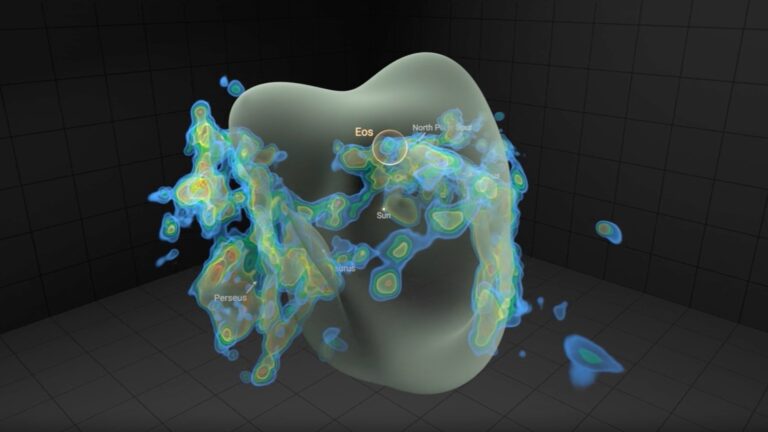
Physics quantum and quantum entanglement, 3d rendering. 3D illustration.
New type of quantum entanglement discovered that will transform real-world technology – Earth.com
2025-04-17T21:50:49Z
Quantum entanglement is challenging researchers to understand how photons seemingly influence each other instantaneously.
Researchers have long studied quantum entanglement to understand how photons appear to influence each other instantaneously.
This peculiar link first emerged when Albert Einstein pointed to what he called “spooky action at a distance,” suggesting that this peculiar behavior contradicted intuitive views of cause and effect.
The conversation around these phenomena has evolved through the decades.
Ph.D. student Amit Kam and Dr. Shai Tsesses from Technion are now adding a twist to this story by exploring surprising effects in photons that occupy incredibly tight spaces.
Understanding quantum entanglement
Quantum entanglement is a strange but very real phenomenon where two particles become linked in such a way that their states depend on each other, even when separated by huge distances.
Imagine you take a pair of gloves, put one in a box, and send it to the other side of the universe. The moment you open the box and see a left glove, you instantly know the other box has the right one.
With entangled particles, it’s like that, but much weirder. The twist is, unlike gloves that had a clear identity from the start, entangled particles don’t “decide” their state until someone measures them. And once one does, the other reacts instantly, no matter how far away it is.
Einstein was never fully onboard with quantum entanglement because it seems to break the rule that nothing can travel faster than light.
But time and again, experiments have shown it’s real. No hidden signals. No delay. Just instant correlation.
The origins of entanglement
Einstein’s collaboration with Boris Podolsky and Nathan Rosen produced a classic puzzle that challenged existing ideas.
Their EPR paper helped spark deeper inquiries into how one particle can instantly affect another across vast distances, a phenomenon that puzzled even seasoned physicists.
Years later, the idea reached practical horizons with quantum teleportation, which was conceptualized by Charles Bennett, Gilles Brassard, and Asher Peres.
This opened the door to quantum communication protocols that rely on bizarre correlations only possible in the quantum world.
Tiny photon spaces are revealing
The push to miniaturize devices is not just about saving space. Scaling down light-based components can strengthen the interaction between photons and nearby materials, which may lead to applications that larger-scale systems cannot achieve.
Photons in nanoscale environments showcase new combinations of properties. Instead of seeing separate spin and orbital components, scientists are dealing with total angular momentum, which merges these features into one quantity.
Strange photon actions in small spaces
Most people imagine light beams spreading out freely, but these experiments confine photons into structures tinier than a thousandth the thickness of a human hair.
That restriction forces angular components of light to overlap in unexpected ways, altering how each photon can carry information.
These observations may hold promise for new kinds of quantum devices.
Researchers propose that total angular momentum entanglement might enable more compact hardware for quantum computing or communication links than previously thought possible.
Different kind of quantum entanglement
Several forms of entanglement in photons involve separate characteristics such as direction, frequency, or polarization. In contrast, total angular momentum combines many properties into a single description.
Evidence for this new structure only surfaced when researchers tested how photon pairs behave once they pass through carefully designed nanoscale channels.
The outcomes hinted at correlations that do not resemble conventional entanglement structures in larger settings.
Why does this matter?
Those studying photon-based technologies aim to construct more efficient equipment that harnesses quantum effects for faster computations or stealthy message exchanges.
Smaller components can pack more operations onto a single chip, much like the ongoing trend in electronics.
While some quantum methods focus on established particle attributes, this work suggests that total angular momentum could be an untapped resource.
The miniature systems explored by Technion scientists might offer fresh ways to encode and process data without taking up a lot of space.
Photon control and next steps
Entangled photons, even in conventional systems, are notoriously sensitive to environmental disturbances.
Confining light in tiny spaces can amplify those effects, so the engineering behind these setups must address potential losses or interference.
Researchers also want to confirm whether total angular momentum entanglement behaves reliably in real-world conditions.
Investigations into materials and device architectures are underway, guided by the new data from these nanoscale experiments.
Einstein’s skepticism about instant influence did not stop the scientific community from uncovering new frontiers in quantum theory.
The 2022 Nobel Prize in Physics recognized key contributions that shaped how we measure and interpret entanglement.
Today, the focus has turned toward next-generation experiments that push these correlations into ever-smaller spaces.
By compressing photons into structures below their typical wavelength, scientists hope to uncover possibilities beyond familiar optical behaviors.
What happens next?
Each step in quantum research sparks questions about how nature encodes information.
The notion of merging spin and orbit into a single total angular momentum points to a shift in the thinking about light, especially when devices must stay small.
Further studies may translate these findings into commercial products.
Many experts foresee a path where photons replace electrons in computing tasks, leading to faster speeds and less heat dissipation. This new entanglement feature could become an essential piece of that puzzle.
The study is published in the journal Nature.
—–
Like what you read? Subscribe to our newsletter for engaging articles, exclusive content, and the latest updates.
Check us out on EarthSnap, a free app brought to you by Eric Ralls and Earth.com.
—–
Auto-posted from news source






